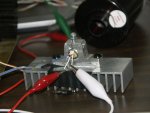drlava
0
- Joined
- Mar 7, 2007
- Messages
- 1,152
- Points
- 0
It appears that perhaps there may be more than one diode type in these burners KAZ over at P.L. is reporting different wavelength and Vds than I am seeing here. I ordered several burners and so far the wavelength has been 658-660 nm (measured with a monochromator). Also the lasing thershold is 75-80mA.
Here is a non-TEC cooled plot (diode temp measured from the back of the diode 20C at the start of the test, 27C at the end) of a run in my automatic tester:

As you can see, it's an impressive diode.
Here is a non-TEC cooled plot (diode temp measured from the back of the diode 20C at the start of the test, 27C at the end) of a run in my automatic tester:
As you can see, it's an impressive diode.






